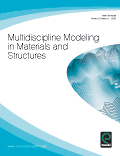
Multidiscipline Modeling in Materials and Structures
Scope & Guideline
Fostering collaboration to elevate materials and structural analysis.
Introduction
Aims and Scopes
- Multidisciplinary Research:
The journal encourages submissions that bridge multiple disciplines, particularly those that combine principles from materials science, structural engineering, and applied mechanics. - Computational Modeling Techniques:
A significant focus is placed on computational methods such as finite element analysis, machine learning, and numerical simulations to solve complex problems in materials and structures. - Innovative Materials Development:
The journal emphasizes research on novel materials, including nanocomposites and hybrid materials, exploring their mechanical, thermal, and electrical properties. - Thermal and Fluid Dynamics Studies:
Research exploring heat transfer, fluid dynamics, and magnetohydrodynamic effects in various materials and structural applications is a core area of the journal. - Experimental Validation and Case Studies:
The journal values empirical research that validates theoretical or computational findings through experiments or real-world case studies, providing practical insights into material behaviors.
Trending and Emerging
- Nanofluids and Hybrid Materials:
There is a significant increase in research related to nanofluids and hybrid materials, particularly their thermal and mechanical properties, reflecting growing interest in enhancing material performance through nanoscale modifications. - Machine Learning Applications:
The integration of machine learning techniques for predictive modeling and optimization in materials science and structural engineering is gaining traction, showcasing the journal's adaptation to modern computational approaches. - Sustainable and Eco-friendly Materials:
Emerging topics related to sustainable materials and eco-friendly engineering practices are increasingly prominent, indicating a shift towards addressing environmental concerns in materials development and application. - Advanced Manufacturing Techniques:
Research exploring additive manufacturing, such as 3D printing of advanced materials, is on the rise, reflecting innovations in fabrication technologies that allow for complex geometries and material properties. - Dynamic and Nonlinear Analysis of Structures:
There is an increasing focus on the dynamic behavior and nonlinear analysis of structures under various loading conditions, emphasizing the need for more sophisticated modeling approaches in real-world applications.
Declining or Waning
- Traditional Structural Analysis Methods:
There is a noticeable decline in the publication of papers focused solely on traditional analytical methods for structural analysis, as more emphasis is placed on advanced computational techniques. - Classical Materials Testing Procedures:
Research centered on conventional materials testing methodologies appears to be less frequent, likely due to the increasing interest in innovative materials and their unique testing requirements. - Static Load Analysis:
Studies focusing exclusively on static load conditions are becoming less common, with a shift towards dynamic and time-dependent analyses that consider real-world loading scenarios.
Similar Journals

COMPUTATIONAL MECHANICS
Unveiling New Horizons in Computational MechanicsCOMPUTATIONAL MECHANICS, published by SPRINGER, is a premier international journal that focuses on the intersection of applied mathematics, engineering, and computational methods. With a commendable Q1 ranking in multiple categories, including Applied Mathematics and Mechanical Engineering, this journal is pivotal for disseminating groundbreaking research and innovative methodologies that advance the field. The journal has steadily contributed to the academic community since its inception in 1986 and continues to lead discussions and practices in computational mechanics and related disciplines. With a robust impact reflected in its Scopus rankings—placing it within the top percentiles across various categories—COMPUTATIONAL MECHANICS serves as a crucial platform for researchers, professionals, and students seeking to explore and contribute to significant advancements in computational theory and mathematical applications. Although it does not currently operate under an open access model, the journal ensures wide accessibility through libraries and institutional subscriptions, fostering a rich exchange of knowledge in the global scientific community.

Journal of Applied Mechanics and Technical Physics
Connecting Scholars to the Future of Applied PhysicsJournal of Applied Mechanics and Technical Physics is a distinguished publication that serves as a vital resource for researchers and professionals in the realms of mechanical engineering, mechanics of materials, and condensed matter physics. Published by MAIK NAUKA/INTERPERIODICA/SPRINGER, this journal has been committed to disseminating high-quality research since its inception in 1965. With a noted presence in the academic community, it holds a respectable Q3 ranking in multiple categories as of 2023, indicating its relevance and contribution to the field. Although it does not currently offer open access, the journal provides valuable insights and advancements through its rigorous peer-review process. Covering a broad spectrum of topics in applied mechanics and technical physics, it aims to foster innovation and dialogue among scientists, engineers, and scholars alike. Located in the United States, the journal continues to make significant strides in bridging the gap between theoretical research and practical applications, making it an essential read for anyone engaged in these dynamic fields.

International Journal of Advances in Engineering Sciences and Applied Mathematics
Elevating Engineering Discourses with Applied MathematicsInternational Journal of Advances in Engineering Sciences and Applied Mathematics, published by SPRINGER INDIA, is a distinguished journal dedicated to advancing research in the fields of engineering sciences and applied mathematics. With a focus on innovative methodologies and applications, the journal provides a platform for researchers, professionals, and students to disseminate their findings and explore new frontiers in engineering and mathematical sciences. The journal seeks to publish high-quality, peer-reviewed articles that address contemporary challenges and promote interdisciplinary collaboration. While currently not an open-access publication, it remains a significant resource for those in academia and industry, fostering a deeper understanding of complex engineering problems through rigorous mathematical frameworks. The journal’s ISSN is 0975-0770, with an E-ISSN of 0975-5616, ensuring a broad dissemination of knowledge in the scientific community.
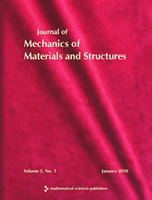
Journal of Mechanics of Materials and Structures
Bridging Theory and Application in Material Sciences.Journal of Mechanics of Materials and Structures, published by Mathematical Science Publishers, is a distinguished periodical in the field of Applied Mathematics and Mechanics of Materials. With the ISSN 1559-3959, this journal has been a pivotal platform since its inception in 2006, providing insights and advancements in the mechanics of materials and their structural applications. Operating out of the University of California, Berkeley, this journal not only boasts a respectable standing within its categories, ranking Q4 in Applied Mathematics and Q3 in Mechanics of Materials as of 2023, but it also serves a crucial role in fostering academic discourse among researchers, practitioners, and students alike. Although it does not currently offer open access, its contributions to the respective fields are invaluable, underscoring the relevance and importance of continued research in understanding material behavior and structural integrity. Whether investigating theoretical frameworks or engineering applications, the Journal of Mechanics of Materials and Structures remains an essential resource for anyone dedicated to the advancement of the science of materials and structures.

Materials Physics and Mechanics
Innovating Insights in Physics and EngineeringMaterials Physics and Mechanics is a pivotal journal dedicated to advancing the fields of condensed matter physics, materials science, mechanical engineering, and the mechanics of materials. Published by the Institute of Problems in Mechanical Engineering, Russian Academy of Sciences, this journal has established itself as a valuable resource since its inception, particularly from 2003 to 2004 and now continuously from 2009 to 2024. Although it currently holds a Q4 categorization in various disciplines, its contributions are critical to understanding and developing new materials and their applications in engineering. The journal provides insightful articles that explore the nuances of material properties, their behaviors under different conditions, and the physical principles governing these phenomena. Though it operates under a traditional publication model, the insights provided within its pages are invaluable to researchers, professionals, and students striving to push the boundaries of knowledge in the materials domain. Its ISSN numbers (1605-2730, E-ISSN 1605-8119) serve as a gateway to a wealth of scientific knowledge emanating from the Russian Federation, contributing to the global discourse in materials physics and mechanics.
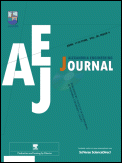
Alexandria Engineering Journal
Unlocking the potential of engineering through shared discoveries.Alexandria Engineering Journal is a premier open access publication dedicated to advancing the field of engineering. Published by ELSEVIER and headquartered in Amsterdam, the Netherlands, this journal has been at the forefront of disseminating innovative research since its inception in the year 2000. With its impressive Q1 ranking within the Engineering (miscellaneous) category and a notable position as #20 out of 307 in the Scopus rankings, it serves as a vital resource for scholars and practitioners alike, ensuring that cutting-edge findings reach a global audience. The journal is accessible to all since adopting open access policies in 2010, thereby facilitating the sharing of valuable insights without barriers. As we approach the convergence of years from 2000 to 2024, the Alexandria Engineering Journal continues to play a pivotal role in shaping engineering practices and underpinning significant advancements in the field.
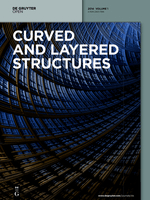
Curved and Layered Structures
Innovating Curved and Layered ArchitectureCurved and Layered Structures, published by DE GRUYTER POLAND SP Z O O, is a distinguished open-access journal that has been an essential platform since 2014 for academics and professionals in the fields of Aerospace Engineering, Architecture, Building and Construction, Civil and Structural Engineering, and Computational Mechanics. With an ISSN of 2353-7396, it is recognized for its impactful contributions, reflected in its impressive category quartiles, particularly Q1 in Architecture and notable rankings in various engineering disciplines. The journal's scope encompasses innovative research focusing on the intricate designs and applications of curved and layered structures, making it pivotal for advancing knowledge in these areas. The open-access format ensures widespread dissemination of research findings, promoting accessibility and collaboration among researchers and practitioners worldwide. As it navigates its converged years from 2014 to 2024, Curved and Layered Structures continues to attract high-quality submissions that push the boundaries of engineering and architectural design.
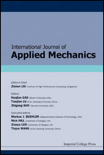
International Journal of Applied Mechanics
Pioneering Research for a Dynamic Engineering LandscapeThe International Journal of Applied Mechanics, published by World Scientific Publishing Co Pte Ltd, is a premier platform that serves the fields of materials science, mechanical engineering, and mechanics of materials. Located in Singapore, this journal has established itself as a crucial resource for researchers, professionals, and students, with its convergence of scholarly work from 2009 to 2024. Ranked in the Q2 category across notable disciplines, including Materials Science, Mechanical Engineering, and Mechanics of Materials, it reflects a strong commitment to publishing high-quality research that pushes the boundaries of knowledge in applied mechanics. Despite being a non-open access journal, its successful Scopus rankings, including an impressive rank of #151 in Mechanical Engineering, signify its substantial impact and recognition within the academic community. This journal not only aims to disseminate pioneering research but also to foster collaboration and innovation in the rapidly evolving landscape of applied mechanics.

Applications in Engineering Science
Exploring the Future of Engineering ApplicationsApplications in Engineering Science is an innovative and highly-regarded open-access journal, published by ELSEVIER in the United Kingdom, focusing on the cross-disciplinary fields of Civil and Structural Engineering, Computational Mechanics, and Mechanical Engineering. Since its inception in 2020, the journal has rapidly established a solid reputation, landing in the Q2 quartile category across multiple engineering disciplines, reflecting its commitment to quality and relevance in the rapidly evolving engineering landscape. With Scopus rankings placing it prominently in the 66th percentile for Computational Mechanics and 58th for Mechanical Engineering, it serves as a vital platform for researchers, professionals, and students alike to share advanced methodologies, innovative applications, and interdisciplinary insights. The journal is committed to fostering open access to cutting-edge research, empowering readers worldwide to stay abreast of significant technological advancements and practical applications in engineering science.

FDMP-Fluid Dynamics & Materials Processing
Exploring the Nexus of Fluid Dynamics and Material InnovationFDMP-Fluid Dynamics & Materials Processing, published by TECH SCIENCE PRESS, stands as a significant contribution to the field of materials science, specifically focusing on the intricate relationships between fluid dynamics and material processing. With an ISSN of 1555-256X and an E-ISSN of 1555-2578, this journal offers an open-access platform where researchers can disseminate their work broadly, promoting collaboration and innovation among professionals and students alike. Established in 2007 and continuously evolving through to 2024, the journal is classified in the Q4 category of materials science, ranking at #347 out of 463 in the Scopus database, signifying its niche yet crucial role in the academic community. By focusing on the dynamic interplay between fluid behavior and material properties, FDMP addresses contemporary challenges and advances in material processing techniques. The journal plays a pivotal role for academics and industry professionals seeking to push the boundaries of knowledge and application in materials science.